Are R&D Tax Credits Available in Arkansas?
Yes. The state of Arkansas provides the Research and Development (R&D) Tax Credit for qualified research expenses (QREs) occurring within the state. Taxpayers must invest in a project under one or more of the R&D programs offered by the Arkansas Science and Technology Authority (ASTA) when the projects directly involve an Arkansas business and must be approved by its Board of Directors. The credit may be earned for the first five years following the signing of a financial incentive agreement with the Arkansas Department of Economic Development (ADED).
Some highlights of the Arkansas R&D tax credits include:
- In-House Research and Development: Businesses conducting research qualifying for federal R&D tax credits may claim a credit of 20% of QREs that exceed the base year, for a period of three years and the incremental increase in QREs for the succeeding two years. For a new in-house research facility, the base year is zero. Therefore, in the first three years following the date of the financial incentive agreement, all eligible expenditures can qualify for the credit. QREs in the 3rd and 4th years are used as the base year to calculate the credits in the 4th and 5th years, respectively. The agreement may be renewed for up to 5 years. May not be used with In-House Research by a Targeted Business Credit.
- Research and Development in Area of Strategic Value: This credit is equal to 33% of in-house QREs (up to $50,000 per taxpayer per year) in conducting research qualifying for federal R&D credits. Research must be in an area of strategic value OR for a project offered by the Arkansas Economic Development Commission (AEDC). Research in an area of strategic value means research in fields having long-term economic or commercial value to the state, and that has been identified in an AEDC-approved R&D plan. May not be used with In-House Research by a Targeted Business Credit.
- University-Based Research and Development: An eligible business that contracts with an Arkansas college or university in performing research qualifying for federal R&D credits may qualify for a 33% credit for QREs. May be used with other In-House R&D Credits.
- In-House Research by a Targeted Business: Upon application and approval by the AEDC Executive Director, targeted businesses may claim a credit of 33% of the QREs incurred each year for up to five years. QREs include expenses incurred in the conduct of research qualifying for federal R&D tax credits. This credit may be sold upon application and approval by AEDC. A targeted business claiming this credit is prohibited from earning job creation tax credits for the same expenses and may not be used with other In-house R&D credits. To qualify as a targeted business, companies must: 1) be less than 5 years old, 2) show proof of an equity investment of at least $250,000, 3) pay at least 150% of the lesser of the state or county average hourly wage where the business is located, 4) meet requisite payroll thresholds, AND 5) additional eligibility criteria for individually targeted programs (sales and use tax refund for targeted businesses, payroll income tax credit for targeted businesses, payroll rebate for targeted businesses and targeted ArkPlus). A targeted business must also be classified by AEDC in one of the 6 targeted emerging technologies: 1) Advanced Materials & Manufacturing Systems, 2) Agricultural, Food and Environmental Sciences, 3) Bio-Based Products, 4) Biotechnology, Bioengineering and Life Sciences, 5) Information Technology, OR 6) Transportation Logistics.
Utilization: The Arkansas R&D tax credit, including any carry forward amount, may be used to offset 100% of Arkansas state tax liabilities. Any amount in excess of the tax liability may be carried forward for a maximum of 9 consecutive tax periods.
Application Required: Taxpayers must apply to the ADED in order to qualify for the Arkansas R&D tax credit for research under programs of the ASTA. Application for this credit must include a project plan that clearly identifies the intent of the project, the expenditures planned, the project start and end dates, and a total project cost estimate. The ASTA specifies the application format for its programs. The ASTA must approve any research for which a taxpayer is seeking credit under this incentive. To claim a credit, a taxpayer must file the Certificate of Tax Credit issued by the ASTA with the tax return on which the credit is first claimed. (Reg. VIIE4b, Consolidated Incentive Act (Act 182 of 2003) Regulations, Research Under ASTA Programs)
Exclusive Provision: Taxpayers claiming the Arkansas R&D credit cannot receive the credit granted by Sec. 26-51-1102(b), A.C.A. for the same expenditures.
Arkansas R&D Tax Credit Case Study
A medical research company in Fort Smith, Arkansas had never claimed the R&D Tax Credits before. This project involved the tax year 2021. The Company qualified for the federal R&D Tax Credit of $75,000 and an additional $99,000 of state R&D Tax Credit in Arkansas.
|
FEDERAL
|
ARKANSAS
|
|||
|
Year
|
Total QREs
|
Credit
|
Total QREs
|
Credit
|
|
2021
|
$750,000
|
$75,000
|
$300,000
|
$99,000
|
You can read more about this Arkansas case study here.
Four-Part Test
Qualified research activities are defined by the four-part test outlined below
Technological in Nature
Activities must fundamentally rely on the principles of physical or biological science, engineering, or computer science.Permitted Purpose
Activities must be performed in an attempt to improve the functionality, performance, reliability, or quality of a new or existing business component.Eliminate Uncertainty
Activities intended to discover information that could eliminate technical uncertainty concerning the development or improvement of a product.Experimentation
All activities must include a process of experimentation including testing, modeling, simulating, and systematic trial and error.Research and Development Tax Insights
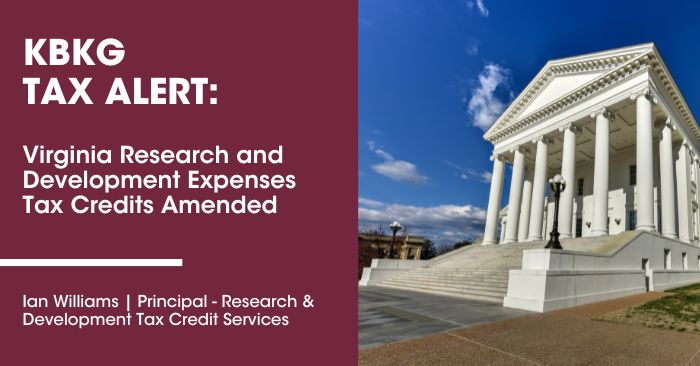
Virginia Research and Development Expenses Tax Credits Amended
04/15/2024KBKG Tax Alert: Virginia Research and Development Expenses Tax Credits Amended By Ian Williams| Principal, R&D Tax Credits Effective July 2024, Virginia’s Governor Youngkin signed legislation that impacts Virginia’s major research and development expenses tax credit. The changes include a decreased major R&D expenses cap, a new credit calculation method, and an increased R&D expenses … Read More
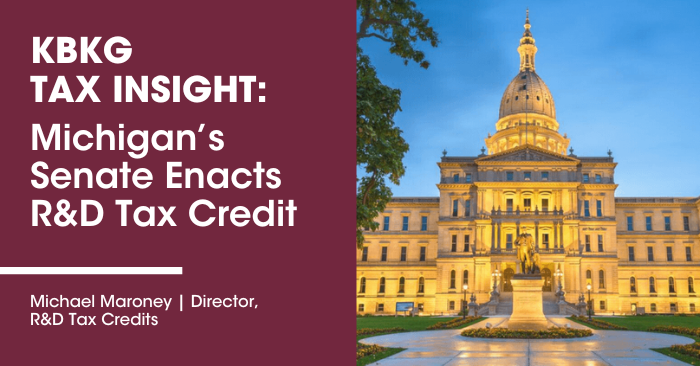
Michigan’s Senate Enacts R&D Tax Credit
03/25/2024KBKG Tax Insight: Michigan’s Senate Enacts R&D Tax Credit By Michael Maroney | Director, R&D Tax Credits On March 19, 2024, Michigan’s Senate passed legislation enacting an R&D credit, the first of its kind since the R&D credit expired over a decade ago. The Senate passed HB 5100, which the Democrat-led Michigan House passed on … Read More
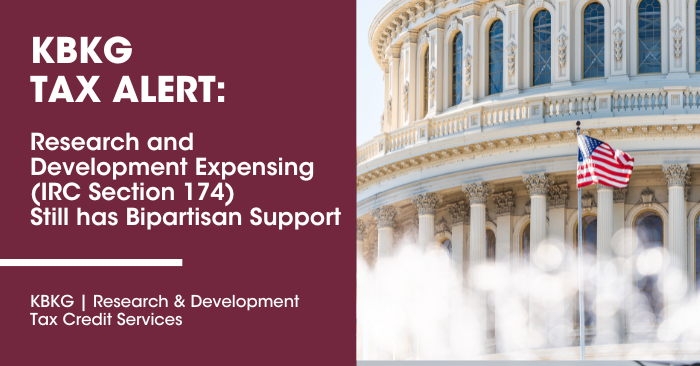
Research and Development Expensing (IRC Section 174) Still has Bipartisan Support
03/22/2024KBKG Tax Alert: Research and Development Expensing (IRC Section 174) Still has Bipartisan Support During a March 21 hearing on President Biden’s Fiscal 2025 budget, members of the Senate Finance Committee urged Treasury Secretary Janet Yellen to remember federal research and development (R&D) tax incentives to improve the United States’ economic competitiveness. The R&D tax … Read More
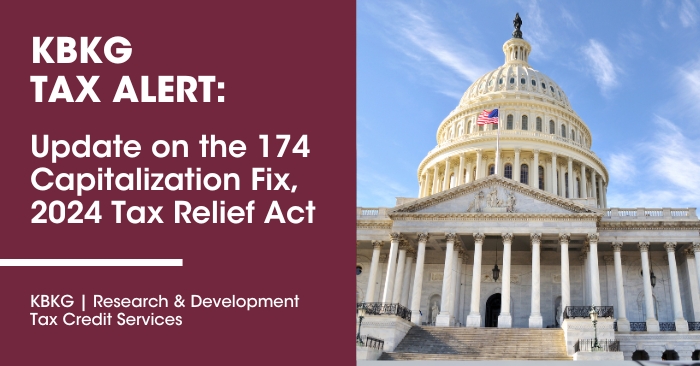
KBKG Tax Alert: Update on the 174 Capitalization Fix, 2024 Tax Relief Act
03/11/2024KBKG Tax Alert: Update on the 174 Capitalization Fix, 2024 Tax Relief Act The American Families and Workers Act of 2024 (“the Act”), aimed at reinstating the ability to deduct R&D expenditures, extending bonus depreciation, and expanding the Child Tax Credit has hit a significant roadblock in the Senate. Despite its bipartisan passage in the … Read More

Biotech R&D Tax Benefits
03/01/2024Understanding R&D Tax Credits for Biotech, Bioscience, and Pharma Research and development (R&D) is a huge part of the biotech, bioscience and pharmaceutical industries. Biotech, bioscience, and pharmaceutical companies operate on the forefront of innovation, constantly seeking new solutions to complex problems through cutting-edge technology and scientific research. R&D is the lifeblood of these industries, … Read More

R&D Tax Credit for Robotics Industry
02/26/2024R&D Tax Credits for Robotics Industry If you run a small business, large corporation, or a startup, business payroll taxes could take a big bite out of your profitability. Companies in the robotics industry can lower their tax burden with the research and development (R&D) tax credit. This tax credit can help businesses developing exciting innovations … Read More

Common Misconceptions About R&D Tax Credits: Debunking Myths and Clearing Up Confusion
02/26/2024Common Misconceptions About R&D Tax Credits: Debunking Myths and Clearing Up Confusion The R&D credit refers to tax-saving opportunities for companies that invest in research and development. The R&D tax credit incentivizes businesses of all sizes to develop or improve products and processes within their industry. Unfortunately, many misconceptions may unnecessarily stop a company from claiming the … Read More

Tax Credits for Developing Battery Tech and Chemicals for Electric Vehicles
01/31/2024Using the R&D Tax Credit to Join the EV Market The production and sale of electric vehicles (EVs) are on the rise, with more consumers switching to this eco-friendly option each year. The EV market has witnessed substantial growth, driven by factors such as increasing environmental awareness, government incentives, advancements in battery technology, and improvements … Read More

How the PATH Act Helps Small Businesses
01/31/2024Understanding R&D Tax Credits for Forest Products | KBKG Companies in the forest products industry increasingly rely on research and development initiatives to optimize manufacturing, increase revenue, and create a competitive edge. Even small and medium-sized forestry businesses may qualify for valuable tax incentives related to R&D. Unfortunately, the U.S. Chamber of Commerce estimates that … Read More
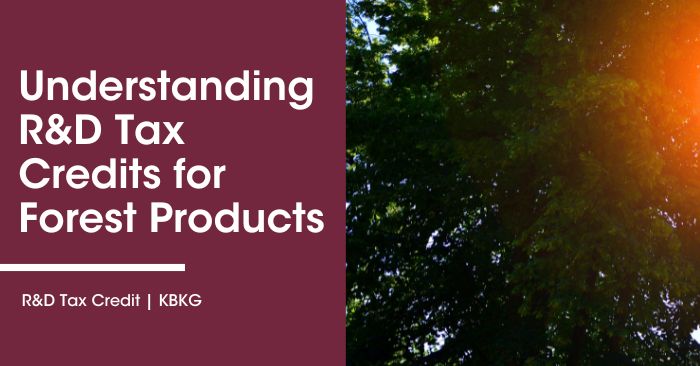
Understanding R&D Tax Credits for Forest Products
01/31/2024Understanding R&D Tax Credits for Forest Products | KBKG Companies in the forest products industry increasingly rely on research and development initiatives to optimize manufacturing, increase revenue, and create a competitive edge. Even small and medium-sized forestry businesses may qualify for valuable tax incentives related to R&D. Unfortunately, the U.S. Chamber of Commerce estimates that … Read More


